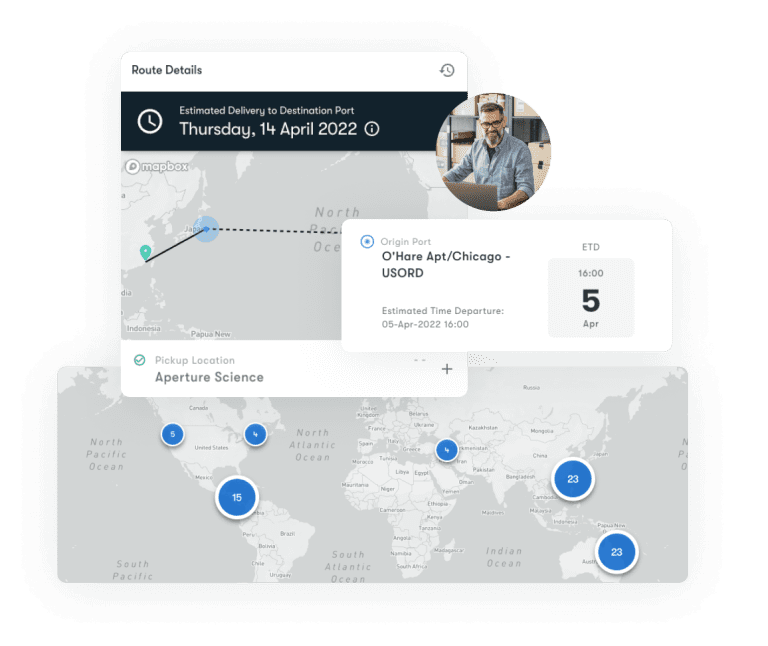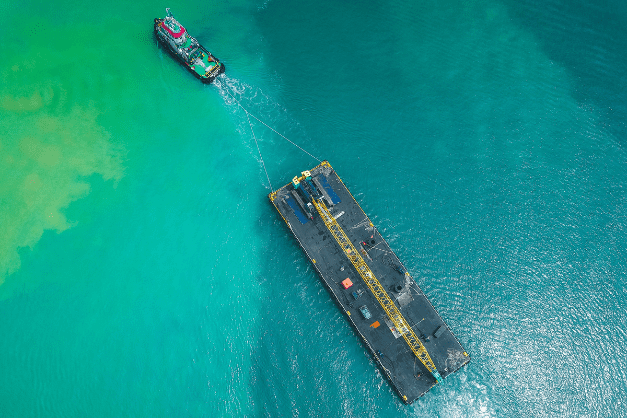In this article
Predicting freight delivery times has never been a simple task. Particularly for ocean forwarders, shipment times can be especially volatile– with prolonged delays from port congestion, customs issues, and more.
But with today’s modern solutions, real-time shipment updates are becoming increasingly accessible– enabling many forwarders to provide their customers with more accurate insights on their ocean freight. Despite that, only a fraction of global freight services take advantage of it– leading them to miss out on reduced costs, improved customer relationships, and time saved.
Let’s talk about how you can maximize freight visibility across your ocean shipments to streamline operations and level up your customer experience.
What is ocean freight visibility?
Ocean freight visibility refers to the process of making key shipment information accessible to stakeholders across your supply chain. This may include data like shipment status, location, ETA, identification, and more. However, it doesn’t just mean sending out a cargo tracker link so your customer can follow each shipment’s journey across the ocean.
Rather, it comes down to centralizing your shipments to provide a full picture of what’s happening. This might look like a shared single source of truth dashboard to consolidate shipment information, a centralized messaging tool, or a go-to screen to reflect updates with real-time accuracy.
Many ocean forwarders will try to achieve the safe effect through manual communication. Instead of giving customers access to their data, they’ll simply send updates and alerts as they come in.
However, even when you’re delivering the same information, providing ad hoc updates falls short on efficiency, communication, and transparency. Building out this “single pane of glass” is the foundation of true visibility and transparency, which will strengthen trust and open you up to more productive conversations.

Why ocean freight visibility is a must for forwarders
Achieving visibility over your ocean freight isn’t easy. Barring telescopic vision, you can’t know with certainty what’s happening halfway around the world. However, as logistics tech evolves, real-time visibility is becoming more widespread– and therefore, more necessary to compete.
Evolving customer expectations
Providing visibility into the shipment journey is becoming an increasingly common ask for international freight forwarders. In a survey by FreightWaves and Logixboard, 81% of shippers said that online shipment visibility is “table stakes” or “a critical part of how we evaluate a forwarder’s offering.”
This request isn’t exactly new. Customers have always wanted more visibility over their shipments, but it hasn’t traditionally been widely accessible. The difference now is that new tech is expanding across the market, enabling shippers to be pickier in their decisions.
As supply chain digitization accelerates and digital-first competitors become more prominent in the industry, refusal to offer enhanced features like visibility is putting you at a disadvantage. In fact, in the FreightWaves/Logixboard survey, 46% of shippers said that they’ve stopped working with a freight forwarder in favor of another with better technology.
Establishing trust with partners
As any FF knows, investing in relationships is essential to success in this industry. Consistently providing visibility is a key factor in building connections to withstand constant competition and movement in the market.
Transporting cargo across the globe is far from an exact science– especially in ocean freight, where bad weather is the cause of 80% of delays. In this industry, mishaps are bound to happen, and unexpected delays are bound to arise. How you communicate and manage those situations will determine your customer’s experience.
For instance, while shippers certainly prefer on-time shipments, they also want to be updated promptly if something is running late. However, when delivering updates manually, it can be tempting for forwarders to push back bad news to avoid upsetting the customer. While this may avoid a tough conversation in the short term, it can seriously damage their reputation in the long term.
When you provide real-time visibility into your global freight services, you don’t need to worry about when to alert your customers about an updated ETA. At the same time, since they have access to the same shipment information as your team, they can trust that they’re always getting immediate updates.
Operational efficiency
Not only is ocean freight visibility a top priority for your customers, but it can also pay off internally by improving efficiency and saving time for your team.
As discussed, replacing manual alerts with a visibility solution can strengthen trust and relationships with your customers. However, it can also improve productivity for your team by eliminating time spent delivering those updates.
In theory, each update only takes about 30-seconds to send, or less if you set automated triggers. However, the cost of losing work can be much higher. According to a report by Qatalog and the Idea Lab at Cornell University, people report taking an average of 9.5 minutes to get back into a workflow after switching apps. By cutting down on tedious, manual tasks assigned to your employees, you can give them more time and energy to focus on more complex projects.
In addition to cutting down on manual tasks, the benefits of a centralized visibility platform can enable more productive communication. Since your team will share a view with customers, you can run more efficient customer meetings without prepping piles of materials beforehand. Additionally, your single source of truth can even improve internal collaborations by eliminating time spent fussing over details.
Getting started: How to provide visibility into your ocean freight
When it comes to tracking your ocean freight shipments, you have a few different options, from connecting your customers with your carrier’s track and trace portal to equipping containers with internet of things (IoT) devices.
However, as discussed, simply tracking your shipment’s location throughout its journey isn’t enough to provide your stakeholders with real visibility. Rather, it begins with onboarding your organization onto a software solution to provide real-time information in a single place.
To find the right software for your organization, you’ll want to focus on a few questions:
- Outcome alignment: What are your goals, and what strategies will this software partner use to help you achieve them?
- Integration compatibility: Does this software partner integrate into your current tech stack?
- Time to value: How long will it take you to start seeing a return on your investment after onboarding this new software?
- Hands-on support: What does onboarding look like with this software partner? Will they work with you to drive success?
Learn more about choosing the right solution in our blog post: How to Evaluate 3PL CX Platforms.
Build vs. buy
When it comes to evaluating software, many teams start with the conversation of whether to build or buy their solution. While they both have their strengths and weaknesses, the best decision depends on many factors, including your company’s needs, your technical capacity, and the options on the market.
For many FFs, particularly SMBs, we find that buying a visibility platform is more effective when it comes to cost, maintenance, and time to value.
Dive into the pros and cons in our blog post: Why to Buy, Not Build, Your Digital Customer Experience.
“Adopting Logixboard let us double down on improving transparency for all of our customers. This transparency is a huge part of our dedication to service, and is especially important as carriers continue consolidating, which leads to more blank sailings, higher rates, and ultimately, more variability.”
– Jason Fowler, President of Air & Sea International
A Word from a Logixboard Customer ?
Final thoughts
Enabling visibility into your ocean shipments is no small task, but adding it to your offerings can pay huge dividends for you and your customers. As international freight forwarders increasingly leverage technology to strengthen logistics relationships, the industry is moving toward transparency one way or another.
Utilizing technology to enhance your customer experience can make or break a business in our digital age. Driving more revenue and customer retention is made possible by implementing the right tools at the right time…aka as early as you can.
If you’re interested in learning more about how Logixboard can help you deliver these outcomes, book a free live demo with our team to see our market leading customer experience platform in real time. We don’t add stress or the need to rip and replace your current TMS, we integrate and handle all of the heavy lifting. Learn more about how we can partner with you and your team today.
READ MORE FROM THE LOGIXBOARD BLOG

